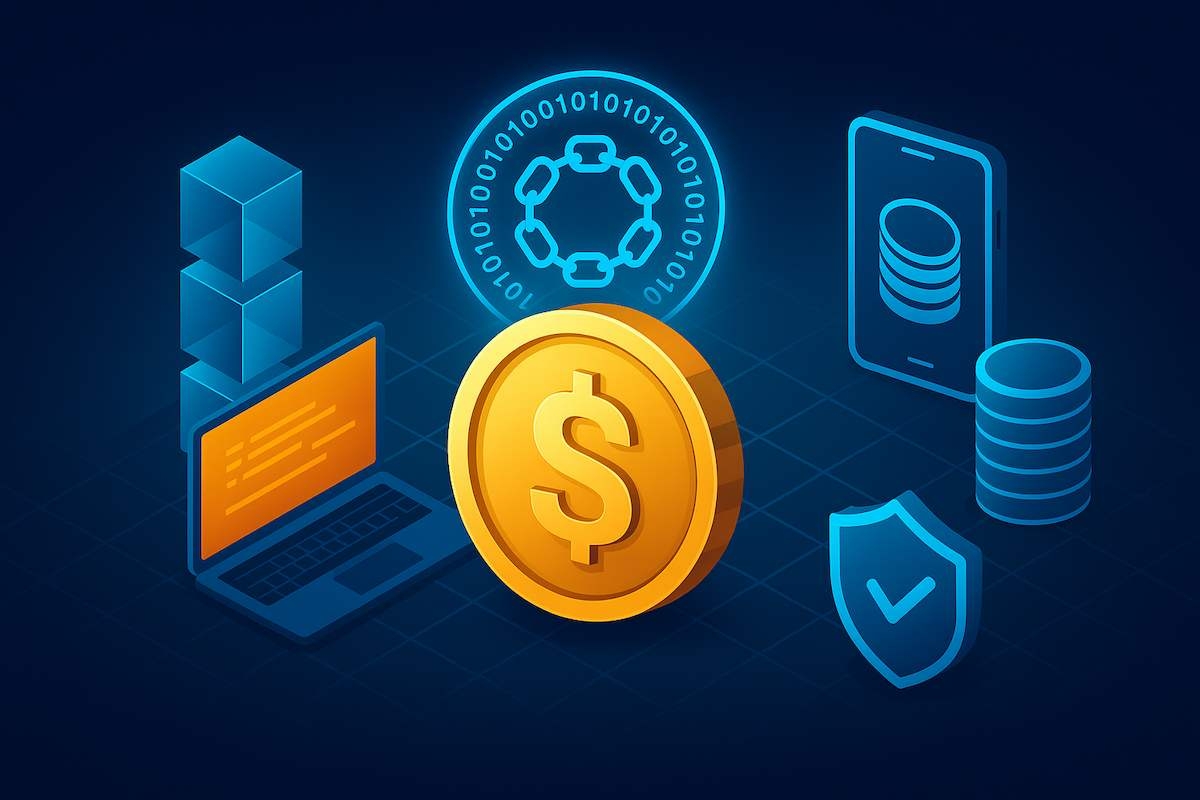The financial landscape in 2025 is undergoing a major transformation, driven by the convergence of blockchain technology, digital assets, and decentralized finance (DeFi). Among these innovations, stablecoins digital currencies pegged to stable assets such as fiat currencies or commodities are emerging as a cornerstone of the modern digital economy. Over the past few years, stablecoins have evolved from simple payment tools to powerful financial instruments driving business innovation, transparency, and global liquidity.
Businesses across industries are now embracing custom stablecoin solutions to streamline transactions, reduce volatility, and enhance cross-border payment efficiency. Whether it’s a global enterprise looking to modernize its treasury operations or a fintech startup aiming to revolutionize digital payments, custom stablecoins are proving to be the backbone of sustainable and secure financial ecosystems.
In this article, we’ll explore why businesses are investing heavily in custom stablecoin development in 2025, analyzing the benefits, use cases, and strategic advantages that make them a top choice for forward-thinking organizations.
The rising demand for stability in the volatile crypto market
Cryptocurrency markets are known for their volatility, and this has always been a barrier for mass adoption. Businesses that rely on digital assets for transactions or investments often face unpredictable fluctuations in asset value, making accounting, payroll, and settlements complex.
Stablecoins offer a practical solution. By pegging their value to stable assets like USD, EUR, or gold, stablecoins eliminate the volatility factor while retaining the speed and efficiency of blockchain transactions.
In 2025, as the global economy becomes increasingly digitized, more companies are turning to custom stablecoin development to create proprietary currencies that suit their financial models. These tailor-made stablecoins allow companies to maintain consistent value for payments, rewards, or internal economies, reducing financial risk and ensuring operational stability.
Global payment efficiency and cross-border transactions
Cross-border payments have long been plagued by inefficiencies, high costs, and slow processing times. Traditional banking systems rely on intermediaries and complex SWIFT networks that often take days to settle international payments.
Custom stablecoins revolutionize this process by offering instant, low-cost, and transparent global payments. A business can issue its own stablecoin backed by fiat reserves or other assets, allowing instant transfers between global subsidiaries, partners, and customers—without reliance on traditional intermediaries.
In 2025, many multinational corporations are leveraging stablecoin infrastructures to facilitate real-time international settlements, enhancing liquidity and operational efficiency. Moreover, blockchain transparency ensures that every transaction is traceable, improving auditability and compliance across jurisdictions.
Enhanced transparency and trust in business transactions
In a world where transparency is crucial, businesses are using custom stablecoins to foster trust among partners, customers, and regulators. Blockchain technology ensures that every stablecoin transaction is recorded on a distributed ledger, offering a clear, immutable audit trail.
This transparency minimizes fraud, double-spending, and data manipulation issues that often plague traditional financial systems. Businesses in industries such as supply chain management, logistics, and e-commerce are adopting asset-backed stablecoins to track goods, verify authenticity, and manage digital payments seamlessly.
By integrating custom stablecoins into their payment ecosystems, companies enhance accountability and transparency, ultimately boosting their brand reputation and customer confidence.
Improved liquidity management for enterprises
For large organizations, liquidity management is a continuous challenge. Managing multiple currencies, foreign exchange risks, and payment delays can impact cash flow and profitability.
Custom stablecoins enable businesses to tokenize their fiat reserves or assets, providing immediate liquidity on blockchain networks. This allows enterprises to move funds between accounts or across borders in real-time, without incurring conversion fees or facing liquidity bottlenecks.
In 2025, advanced treasury management solutions powered by enterprise-grade stablecoins are becoming a standard practice. Companies can use smart contracts to automate payments, streamline financial operations, and maintain liquidity balance efficiently all while ensuring compliance with local and international regulations.
Integration with decentralized finance ecosystems
One of the biggest reasons businesses are investing in custom stablecoins in 2025 is their seamless integration with DeFi platforms. Decentralized finance has unlocked access to lending, borrowing, staking, and yield farming opportunities traditionally reserved for banks and institutional players.
By issuing their own stablecoins, companies can interact directly with DeFi protocols, offering liquidity or earning passive income through decentralized lending. These integrations not only diversify business revenue streams but also provide exposure to innovative financial products and markets.
Moreover, custom stablecoins offer control businesses can set specific rules, governance structures, and redemption mechanisms aligned with their operational and regulatory needs, unlike public stablecoins that are governed by third parties.
Reducing transaction fees and operational costs
Traditional financial systems involve intermediaries at every step from payment processors to correspondent banks each charging transaction and service fees. For global companies processing thousands of transactions daily, these costs can accumulate rapidly.
Custom stablecoin solutions eliminate most intermediaries by enabling peer-to-peer digital transactions. Businesses can design private blockchain ecosystems or permissioned networks for internal settlements, drastically reducing transaction costs and improving overall efficiency.
In 2025, stablecoins are being integrated into digital commerce, gaming platforms, and B2B ecosystems, where real-time micropayments and smart contract automation lead to significant cost savings and better scalability.
Regulatory compliance and transparency in 2025
The regulatory environment for stablecoins is becoming more structured globally, and this has encouraged businesses to build compliant, custom stablecoin systems tailored to their regional and industry-specific regulations.
In the U.S., the European Union, and several Asian countries, regulatory bodies now recognize and provide frameworks for issuing asset-backed digital currencies. Businesses developing stablecoins can implement built-in compliance features like Know Your Customer (KYC), Anti-Money Laundering (AML), and transaction monitoring tools to align with these legal requirements.
By 2025, businesses that adopt compliant stablecoin models not only avoid legal challenges but also position themselves as trusted innovators in digital finance. Regulatory clarity has transformed stablecoin development from a risky venture into a mainstream financial strategy.
Supporting Web3 and digital transformation initiatives
The rise of Web3 ecosystems where decentralization, interoperability, and user empowerment are key principles has amplified the importance of digital currencies. Businesses entering Web3 markets, such as metaverses, DeFi platforms, and decentralized applications (dApps), require a stable and interoperable payment system.
Custom stablecoins bridge the gap between traditional finance and the decentralized digital economy. They serve as universal currencies across Web3 ecosystems, allowing users to transact, stake, and trade seamlessly.
By 2025, many enterprises are issuing brand-based stablecoins for customer loyalty programs, in-app purchases, and decentralized marketplaces, effectively driving brand engagement and user retention while participating in the broader Web3 transformation.
Strengthening customer engagement and loyalty programs
Businesses are always seeking innovative ways to engage customers, and stablecoins are opening new possibilities in loyalty and rewards systems. Instead of traditional reward points that hold limited value, stablecoin-based loyalty tokens can be redeemed across multiple platforms or exchanged for fiat currencies.
For instance, airlines, e-commerce giants, and hospitality brands are now creating custom stablecoins that function as universal digital assets within their ecosystems. Customers earn these tokens through purchases or participation, which they can later use for discounts, services, or even trading.
This approach not only enhances customer engagement but also creates decentralized economic systems where users have tangible ownership of rewards, fostering brand loyalty and long-term retention.
Tokenization of real-world assets
The tokenization of real-world assets is one of the most groundbreaking trends in blockchain technology, and stablecoins play a central role in facilitating this ecosystem. By 2025, companies are using custom stablecoins to tokenize commodities, real estate, carbon credits, and even intellectual property.
These stablecoins serve as mediums of exchange and settlement within tokenized marketplaces, ensuring that transactions remain stable and predictable. Asset tokenization backed by stablecoins allows businesses to unlock liquidity from traditionally illiquid assets, enabling fractional ownership and faster capital movement.
For example, a real estate firm can issue stablecoins pegged to property values, allowing investors to participate in fractional property ownership without the volatility of cryptocurrencies like Bitcoin or Ethereum.
Enabling seamless corporate treasury operations
Corporate treasuries are increasingly adopting blockchain-powered solutions to optimize financial processes. Custom stablecoins provide a programmable financial layer that allows automation of treasury operations such as vendor payments, payroll disbursements, and investment management.
Stablecoin-powered smart contracts can automatically execute payments once conditions are met, ensuring transparency, accuracy, and efficiency. Additionally, custom stablecoins enable treasurers to maintain multi-currency accounts, minimizing forex risks and optimizing liquidity allocation.
In 2025, global enterprises are leveraging these systems for real-time reconciliation, reduced settlement delays, and enhanced capital efficiency—a major leap forward from traditional treasury models.
Strengthening business ecosystems and partner networks
Stablecoins are not just financial instruments they are ecosystem enablers. Businesses are increasingly launching B2B stablecoin networks to enhance collaboration and financial transparency among partners, vendors, and service providers.
By implementing a shared stablecoin system, all parties in a supply chain or partner network can transact with a unified, stable digital currency, reducing friction caused by currency conversions and delayed payments.
For instance, logistics and manufacturing companies are issuing industry-specific stablecoins to standardize settlements across global supply chains. These ecosystems improve operational visibility, speed, and trust among all stakeholders.
Driving innovation in fintech and banking
The fintech revolution continues to reshape financial services, and stablecoins are at the forefront of this disruption. Custom stablecoins empower banks, neobanks, and fintech startups to offer cutting-edge products such as programmable payments, instant remittances, and digital savings accounts.
In 2025, traditional banks are collaborating with blockchain developers to issue regulated stablecoins for retail and institutional use, bridging the gap between conventional banking systems and decentralized finance. These innovations are redefining financial accessibility, inclusivity, and efficiency worldwide.
Moreover, fintech companies are utilizing stablecoins to launch cross-border lending and microfinance solutions, ensuring faster credit access for underbanked populations.
Environmental and sustainable finance initiatives
As environmental sustainability becomes a corporate priority, stablecoins are emerging as tools to promote green finance and carbon accountability. Companies are issuing stablecoins backed by carbon credits or renewable energy assets, creating transparent ecosystems for tracking and trading sustainable resources.
These eco-friendly stablecoins help businesses monitor emissions, fund climate initiatives, and demonstrate ESG (Environmental, Social, and Governance) compliance transparently.
In 2025, custom green stablecoins are becoming a benchmark for organizations seeking to align profitability with sustainability goals, bridging blockchain innovation and environmental responsibility.
Competitive differentiation and brand innovation
In an increasingly digital marketplace, businesses are using custom stablecoins to differentiate their brands and strengthen their digital presence. Launching a proprietary stablecoin not only signals technological leadership but also enhances brand loyalty and market perception.
Companies across retail, gaming, and entertainment are designing branded stablecoins to represent their ecosystems. For instance, a gaming company might issue stablecoins for in-game purchases and player rewards, creating an integrated, immersive economy.
Such innovations offer a unique competitive edge, attracting digital-native customers and investors who value transparency, interoperability, and financial empowerment.
Conclusion
In 2025, the rapid adoption of blockchain and digital currencies has pushed businesses to rethink how they manage payments, liquidity, and financial operations. Custom stablecoin solutions are no longer experimental they have become strategic assets driving innovation, efficiency, and global competitiveness.
From cross-border settlements and DeFi integrations to asset tokenization and sustainable finance, the applications of stablecoins extend far beyond simple transactions. They represent a future where businesses control their digital economies, eliminate intermediaries, and embrace transparency and automation at scale.
As global regulations mature and blockchain infrastructures evolve, the businesses that invest in custom stablecoin development today will be the pioneers shaping the next generation of finance tomorrow.






